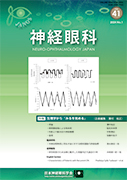Current issue
Displaying 1-8 of 8 articles from this issue
- |<
- <
- 1
- >
- >|
Prefatory Note
-
2024 Volume 41 Issue 1 Pages 1
Published: March 25, 2024
Released on J-STAGE: April 11, 2024
Download PDF (1506K)
Guest Articles
-
2024 Volume 41 Issue 1 Pages 2
Published: March 25, 2024
Released on J-STAGE: April 11, 2024
Download PDF (555K) -
2024 Volume 41 Issue 1 Pages 3-8
Published: March 25, 2024
Released on J-STAGE: April 11, 2024
Download PDF (1028K) -
2024 Volume 41 Issue 1 Pages 9-13
Published: March 25, 2024
Released on J-STAGE: April 11, 2024
Download PDF (4011K) -
2024 Volume 41 Issue 1 Pages 14-23
Published: March 25, 2024
Released on J-STAGE: April 11, 2024
Download PDF (5095K)
Original Articles
-
2024 Volume 41 Issue 1 Pages 24-32
Published: March 25, 2024
Released on J-STAGE: April 11, 2024
Download PDF (6483K)
Case Reports
-
2024 Volume 41 Issue 1 Pages 33-38
Published: March 25, 2024
Released on J-STAGE: April 11, 2024
Download PDF (3064K)
English Section
-
2024 Volume 41 Issue 1 Pages 39-44
Published: March 25, 2024
Released on J-STAGE: April 11, 2024
Download PDF (1717K)
- |<
- <
- 1
- >
- >|
